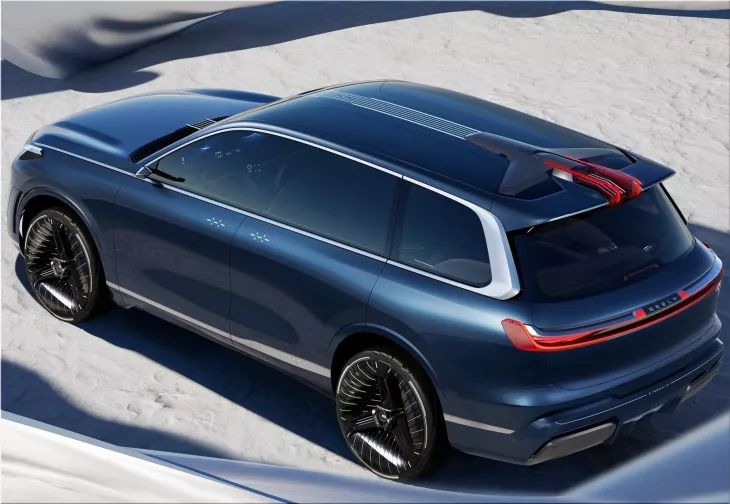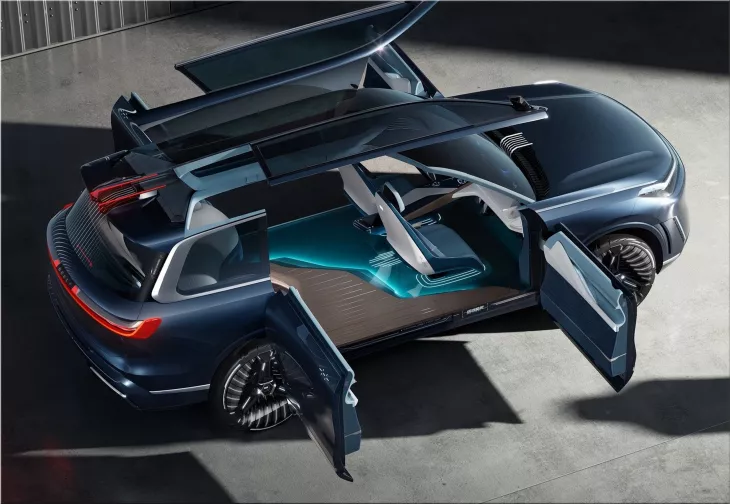Geely Galaxy Starship: Innovation Meets Sustainability in a PHEV ConceptPosted by Florin Muna on April 28th, 2024  The 2024 Beijing Auto Show witnessed the unveiling of a concept car that stole the spotlight: the Geely Galaxy Starship. This futuristic PHEV (Plug-in Hybrid Electric Vehicle) has sent ripples through the automotive industry, hinting at the exciting technological advancements Geely has in store for the future. A Head-Turning DesignThe Geely Galaxy Starship is a visual masterpiece that breaks away from conventional SUV designs. Its sleek, aerodynamic silhouette with a dramatically sloping roofline creates a sense of dynamism. At the same time, the expansive LED light bar that stretches across the front adds a touch of futuristic flair. Large, stylish wheels with a triangular, low-wind resistance design complement the overall look. Upswing scissor doors further elevate the car's aesthetics, making it a true head-turner on the road. These doors are likely not just for show; their design can improve passenger ingress and egress, especially considering the expected high ground clearance of an SUV. The Galaxy Starship's interior is a testament to Geely's commitment to innovation and passenger comfort. Imagine stepping into a spacious cabin bathed in natural light, designed to seamlessly integrate with nature. Geely refers to these design sections as Water, Yacht, and Shore, each likely representing a unique ambience and functionality.
One of the interior's most captivating features is the expansive digital screen that stretches across the dashboard, providing vital information and entertainment options to the driver and passengers. A panoramic surround sound system creates an immersive auditory experience, while AI-powered smart seats that adjust to individual preferences offer unparalleled comfort and customization. Imagine seats that automatically adjust temperature and lumbar support based on your posture or pre-set preferences. A Glimpse into Geely's Technological ProwessThe Geely Galaxy Starship is a showcase of the brand's cutting-edge technological advancements. The car is built on Geely's new GEA platform, a versatile architecture that can accommodate a variety of powertrains, including pure electric, range extended, and plug-in hybrid options. This platform hints at Geely's potential for future electric vehicle development, showcasing their adaptability and commitment to sustainable transportation solutions. The Starship is a PHEV that leverages Geely's next-generation Thor (NordThor) powertrain system. This innovative system promises a remarkable combined driving range of over 2,000 kilometers (1,242 miles) on a single charge and a fuel consumption rating of under 3.0 liters per 100 kilometers (78 miles per gallon). These figures, if achieved in production models, would position the Galaxy Starship as a leader in fuel efficiency and range. This extended range would be particularly appealing to drivers who frequently embark on long journeys but still desire the flexibility of a gasoline engine for situations where charging infrastructure might be limited. Another intriguing feature is the AI Digital Chassis. This system can dynamically adjust to road conditions in real-time, optimizing suspension settings and steering response for a smoother and safer driving experience. Imagine the car automatically adjusting to potholes, uneven terrain, or sharp corners, creating a more comfortable and controlled ride for all passengers. The concept also features some truly futuristic ideas, like an AI-powered mobile robot that can assist passengers with tasks or retrieve items from the trunk and an AI-powered digital pet that can provide companionship and entertainment during long journeys. While these features might seem like science fiction today, they offer a glimpse into the potential future of in-car entertainment and interaction.
The Future of GeelyThe Geely Galaxy Starship may be a concept car, but it serves as a powerful statement of intent from the Chinese automaker. The car's futuristic design, emphasis on passenger comfort, and innovative technological features provide a glimpse into the exciting direction Geely is headed. With its focus on sustainability, efficiency, and in-car technology, the Galaxy Starship paves the way for a new generation of Geely vehicles that are poised to redefine the automotive landscape. Is the Geely Galaxy Starship Coming to Production? While Geely has not officially announced any production plans for the Galaxy Starship, the positive reception it has received suggests that the car, or a toned-down version of it, could very well find its way to showrooms in the future. Potential Impact of the Geely Galaxy StarshipThe Geely Galaxy Starship concept has the potential to impact the automotive industry in several ways:
Challenges and Considerations While the Galaxy Starship presents exciting possibilities, there are also challenges to consider:
Overall, the Geely Galaxy Starship concept car is a significant development in the automotive industry. It showcases Geely's commitment to innovation, sustainability, and passenger comfort. While challenges remain, the Starship paves the way for a future where cars are not just a means of transportation, but intelligent and personalized companions on our journeys. @via Panorica - Hybrid and Electric Cars. Like it? Share it!More by this author |




